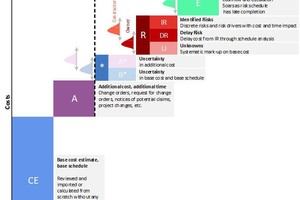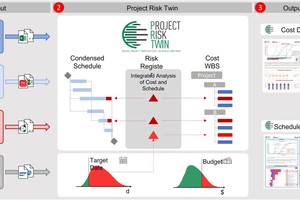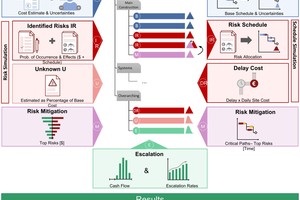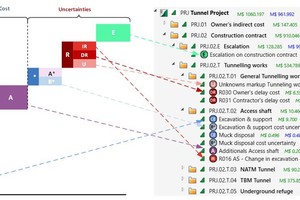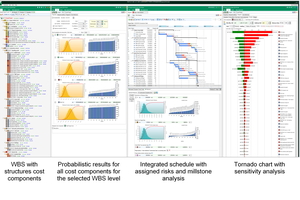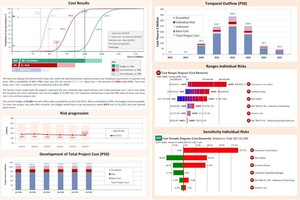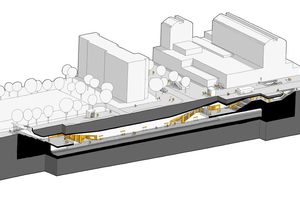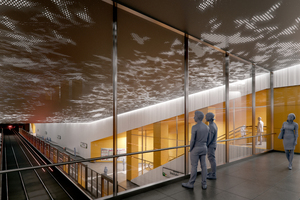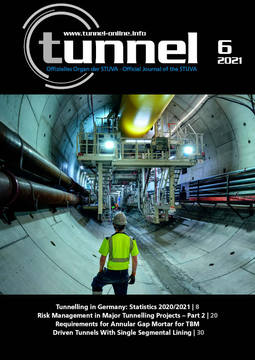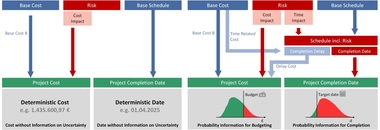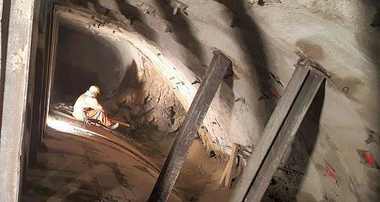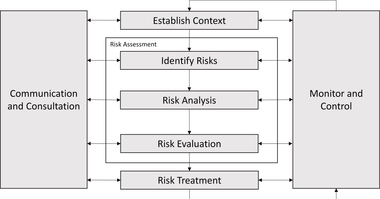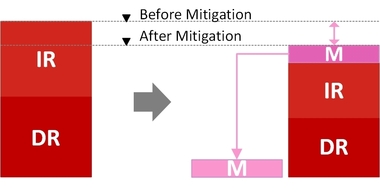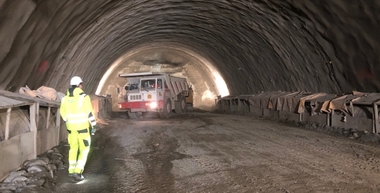Digital Project Risk Twin – Application for the Construction of U5 East, Hamburg
Major projects involve a high investment volume, a high degree of uncertainty, and long durations. In order to cope with this, the use of a digital project risk twin is advantageous, with which uncertainties and dependencies between cost and schedule can be transparently displayed and analysed. The results are summarized in dashboards. Hamburger Hochbahn AG has decided to use such a model for the new U5 East subway line in Hamburg to implement stringent cost and risk management for planning and execution phases. This also results in a continous validation of the budget.
1 Introduction
In the first part, „Risk Management in Major Tunnelling Projects – Part 1: Fundamentals and Success Factors“, the relevance of transparent cost and risk management for large infrastructure projects was presented. The main cost components with their structure and function are again illustrated in Fig. 1. In order to successfully measure and control cost and schedule, a comprehensible assessment of risks is necessary. Probabilistic methods provide valuable information on uncertainties compared to deterministic methods, and enable the validation of the budget [1]. The aforementioned basics from part one are put into practice with a digital project risk twin (PRT). In the following, the basics, the structure as well as the application in the project U5-East in Hamburg will be described.
2 Process Steps for Developing a Digital Project Risk Twin for Cost and Schedule
A Digital Twin (DT) is a representation of a tangible or intangible object or process from the real to the digital world [2]. DT has become a household word in large infrastructure projects as technological advances in modelling and simulation make it applicable. Figure 2 shows the elements of a DT for cost and schedule in infrastructure projects with the corresponding steps: the input/system integration of cost, schedule, risk, and budget data are gathered at the beginning (Fig. 2, 1). In the Project Risk Twin (PRT; Fig. 2, 2), the data is linked by software. Simulation is used to perform an integrated cost and schedule risk analysis including uncertainties. The analysis results are processed and displayed in the form of individually tailored dashboards (Fig. 2, 3).
The PRT is made up of several components. Figure 3 shows chronologically from top to bottom the process steps to create such a model. Starting with basic cost and basic schedule planning, through risk analysis and risk mitigation, to the selection of an approach for escalation (future price increase; cf. Fig. 1).
In the lower part of Figure 3, the results for cost and schedule are shown. Furthermore, a distinction is made between the sub-process for the cost in the left part of the graphic and the sub-process for the schedule in the right part of the graphic. In the middle, the work breakdown structure (WBS) is shown, which structures the recorded cost items hierarchically so that they can be analysed individually. Figure 4 shows an example of how the cost items are integrated into the WBS.
At the beginning of the process (Fig. 3), the base cost are determined and uncertainties for quantities and prices are evaluated [3]. Equivalently, a base schedule is created. It is recommended to have the results validated by external experts.
This is followed by the risk analysis. In the first step, the specific risk scenarios are identified, described and quantified in terms of their probability of occurrence and impact on cost and construction time. In order to take uncertainties into account, the evaluation is carried out by means of three-point estimate (best, expected and worst case). Both positive (opportunities) and negative (threats) effects are considered from the perspective of the two contracting parties, client and contractor.
Risks which could delay construction completion will trigger in most cases also additional time-related cost. To calculate the delay cost the potential delay due to risk impact is linked with time-related cost from base cost [4].
All information is obtained in moderated workshops attended by the client-side project team. A conditioning of the participants is necessary in advance of the workshops. Important goals are to raise awareness with regard to risk management and to reduce optimism bias (self-overestimating optimism).
In the second step of the risk analysis, the unknown risk, consisting of non-identified and non-identifiable risks, is considered. Structured questionnaires are used to evaluate the project based on numerous factors such as maturity, complexity, geological conditions and market situation. The result is a project-specific percentage surcharge on base cost, which also takes into account the quality of the individual risk analysis performed. A higher degree of complexity and particularly unfavourable geological conditions result in a higher surcharge to be applied [5].
For risk management, the impact of the individual risks on the overall project is analysed (e.g., sensitivity analyses, what-ifs, critical paths, etc.). Appropriate risk mitigation measures can be derived from this to mitigate high impact cost and schedule risks. The risk mitigation measures can be quantified in advance by simulations, evaluated in terms of their cost-effectiveness. This provides a solid base for decision-making [6].
The cash outflow over the entire project duration is used to calulated escalation (future price increase). For long-running projects, high inflation cost must be expected due to the compound interest effect, which must be taken into account for both base cost and risks.
After the final simulation of the entire model, the results are transparently summarized by means of dashboards.
Figure 5 shows the implementation of a PRT for a tunnel construction project. The representation here is done with the software RIAAT (Risk Administration and Analysis Tool). In the left part of the picture, the WBS is shown with the cost components. To the right, the probabilistic results of all cost items are shown for the selected WBS level. The next window shows the schedule with assigned risks as well as the prediction of the completion date considering uncertainties. On the far right of the screen, the sensitivity of the individual risks is visualized using a tornado diagram.
Fig. 6 shows the results of the cost analysis of a tunnel based on a fictitious example. On this, for example, the predicted total cost (base cost, risk cost, escalation), cost outflow according to cost components, impact ranges of the individual risks and their sensitivity can be read off. As already described in part one, the s-curves (cf. Fig. 6, top left) can be used to evaluate the robustness of the budget [7].
3 Application of the Digital Risk Twin at the Subway U5 East in Hamburg
In Hamburg, the implementation planning for the U5 East project (City-Nord to Bramfeld), a sub-project of the U5 project, is currently being prepared. The volume of the project is approx. 1.7 billion euros. The fully automated subway line will run over a total length of 5.8 km with five stops from Bramfeld in the east to City Nord [8]. 1.4 km will be built using the cut-and-cover method, 0.4 km above ground and 4.0 km using shield tunneling [9].
The City of Hamburg has set itself the goal of establishing a cost and time monitoring system for public construction projects, especially in the transport sector, which will make it possible to reduce planning deficiencies and avoid unforeseen and uncontrolled cost increases. The city therefore established regulations on so-called “Kostenstabiles Bauen“ (cost-stable construction) [10] at the beginning of the 2010s. The aim is to enable the authorities to plan and implement major projects in time and on budget. A clear project organization with assigned responsibilities is part of this approach. For example, the specialized authorities (for the subway: the Authority for Transport and Mobility Transition) act as the demand side with clear political responsibility for the respective project, including its financing. They select operationally organized implementing agencies (construction departments, state enterprises and public companies) for the planning and implementation of the project. The agencies assign clear tasks, competencies and responsibilities to the parties involved. For the project U5 Hamburg the Hamburger Hochbahn AG (metropolitan transport authority) is the excetuing agency. A central construction monitoring system has been introduced by the Hamburg Senate Office to monitor the cost and schedule development of major construction projects.
Hamburg‘s parliament chooses which project is to be realised and decides on time and budget. As a result of this constellation, it is of central importance for the project owner to always have a transparent overview of the schedule and cost development of the project. This is particularly essential for large and long-term projects. Risk management is the fundamental part.
Hochbahn manages the project operationally in planning and construction for all disciplines, including the GoA4 system technology, acts externally as the owner and informs the technical authority periodically and in a standardized form about the project’s status.
Hochbahn is breaking new ground with implementing risk management in the form of a PRT for the first time in the U5 East project at the start of execution planning. The earlier described PRT for cost and deadlines will initially be used in the execution of the U5 East project and later also in the planning and construction of the U5 Central project. Against the background of the upcoming project tasks, particularly regarding cost and schedule, it was necessary to merge the previous procedure (risk-opportunity management and separate cost and schedule controlling) and to completely restructure it.
The procedure for controlling, risk management and future reporting is described in the project manual “Reporting Cost, Schedule, Risks” and is obligatory.
In conjunction with a regular exchange on these topics, it is ensured that all essential information is also available for the City of Hamburg.
Experience to date shows that the implementation of a PRT in connection with transparent cost controlling offers diverse and new opportunities in project management and reporting. In particular, the early identification of risks, the visualization of the resulting consequences and the possibility of early proactive measures are crucial for project management.
The continuous update of a PRT provides the basis for a holistic cost management that not only maps uncertainties, but also takes into account all project phases and all cost components (base, risk, and escalation cost) to enable stringent project cost control as well as resilient total cost predictions.
With the PRT it is possible to validate budget and completen date. This enables the creation of robust project budgets.
4 Outlook
The third part of the article series “Risk Management in Major Tunnelling Projects“ is based on the fundamentals described in Part One and the project risk twin for integral cost and construction schedule analysis presented in Part Two. It addresses the role of risk management in incentive-based project delivery and contracting models. The PRT provides the basis for developing individual incentive mechanisms. To determine the target cost between the owner and the contractor, the individual risk and opportunity potential for both contracting parties is shown transparently.

